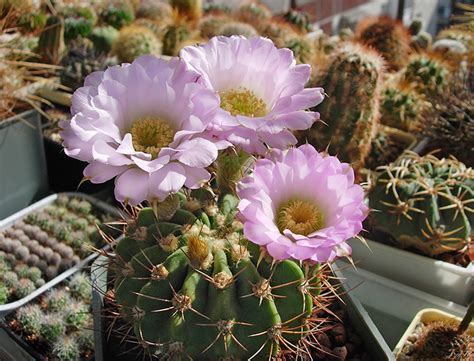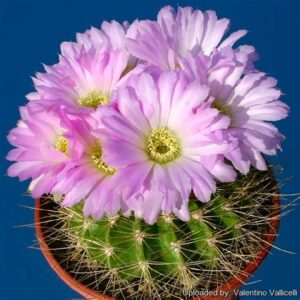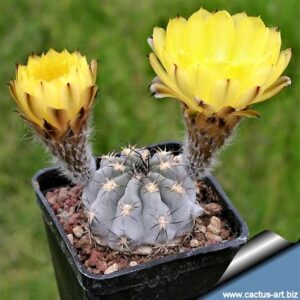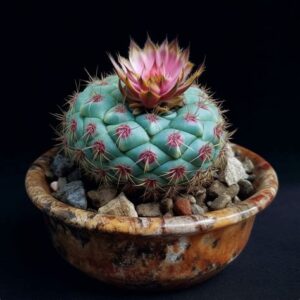The Acanthocalycium minutum is a captivating member of the Cactaceae family, known for its intriguing morphology and vibrant aesthetic appeal. Natively hailing from the arid regions of Argentina, this diminutive cactus showcases a perfect blend of eccentricity and beauty, making it an exceptional addition to any succulent collection. In this extensive guide, we will explore the essential techniques for successfully cultivating Acanthocalycium minutum, emphasizing its unique characteristics and alluring visual presence.
Understanding the Unique Characteristics of Acanthocalycium Minutum
Acanthocalycium minutum stands out among cacti due to its distinctive appearance. This globular cactus achieves a modest size of around 2 to 4 inches in diameter, which makes it an attractive candidate for indoor cultivation or as a standout piece in an outdoor rock garden. Its surface is adorned with prominent tubercles, each armed with a fascinating array of spines that can range in color from white to light brown. These spines not only serve as a defensive mechanism but also contribute to the plant’s visual intrigue.
One of the most striking features of the Acanthocalycium minutum is its flowers. When in bloom, this cactus produces mesmerizing, funnel-shaped flowers that can be yellow, pink, or red, adding a pop of color to your collection. These blooms can grow up to 3 inches in diameter and often rise above the plant in a spectacular display. The flowering period typically occurs in late spring to early summer, creating a small window of opportunity to experience their ephemeral beauty, drawing the attention of both novice gardeners and seasoned aficionados alike.
Soil and Potting Considerations: Crafting the Ideal Habitat
Creating the optimal growing environment is paramount for the successful cultivation of Acanthocalycium minutum. First and foremost, the choice of soil is critical. A well-draining cactus mix is essential, as comprising materials should facilitate excellent aeration and drainage. A blend of potting soil, coarse sand, and perlite in the ratio of 2:1:1 is a recommended formula that will ensure the plant’s roots do not suffocate in overly moist conditions. It is advisable to avoid regular potting soil that tends to retain excessive moisture, as this can lead to root rot—a common nemesis for cacti.
When selecting a pot, opt for one with drainage holes to allow excess water to escape. Terracotta pots are particularly appealing for Acanthocalycium minutum, as they breathe better than plastic. These porous pots wick moisture away from the soil, helping to maintain the delicate balance these cacti require. Additionally, consider using a pot that is slightly larger than the root ball to give the plant room to grow while preventing waterlogged soil.
Location, Location, Location: Light Requirements for Optimal Growth
Positioning your Acanthocalycium minutum in an appropriate location is essential to mimic its native habitat. Full sun exposure is preferable, especially in the morning and late afternoon, when the intensity of the sun is less overwhelming. However, be cautious about the harsh midday rays, particularly in hotter climates. If growing indoors, an unobstructed south or west-facing window will provide the necessary sunlight. In cases of inadequate lighting, artificially supplementing with grow lights can effectively mimic natural conditions.
During the growing season, which spans from spring to early fall, adequate light will promote healthy growth and an impressive blooming cycle. Conversely, during the winter months, it is acceptable for Acanthocalycium minutum to experience a period of dormancy with reduced light and watering, mimicking the natural cycles of dry conditions prevalent in its native environment.
Watering Wisely: Striking the Perfect Balance
Watering is often considered the most challenging aspect of cactus care, and Acanthocalycium minutum is no exception. The cardinal rule is to water sparingly. Allow the top inch of soil to dry out before rehydrating. A general guideline is to water thoroughly, permitting the excess to drain out, and then abstain until the soil has dried. This process seamlessly mimics the infrequent rainfall experienced in its native habitat, instilling a sense of robustness and resilience in the plant.
In the winter months, reduce watering frequency significantly as the plant enters its dormant phase. Overwatering during this time can pose the greatest threat to the well-being of the cactus, leading to soft, mushy tissue and fungal infections. Observing the succulent’s cues will be invaluable. If it begins to wilt or shrivel, that may signify the need for a drink; conversely, if it starts developing a soft texture, it may be time for a more cautious approach.
Nourishment: Appropriate Fertilization for Healthy Growth
Like most cacti, Acanthocalycium minutum thrives with minimal fertilization. However, to encourage robust growth and abundant flowering, a mild, balanced fertilizer specifically formulated for cacti can be applied during the growing season. Diluting the fertilizer to half strength and administering it once every four weeks will provide essential nutrients without overwhelming the plant. During the winter months, it is advisable to refrain from fertilizing, allowing the cactus to rest and recuperate.
Pest Vigilance: Protecting Your Cactus Companion
Although Acanthocalycium minutum is relatively resilient, it is not immune to pests. Keeping a vigilant eye for common offenders such as mealybugs or spider mites will help safeguard your plant. Regular inspections of the undersides of spines and pads will allow early detection of any infestations. If pests are spotted, a gentle application of insecticidal soap or neem oil can effectively combat the issue. Maintaining proper air circulation and avoiding excessive humidity will not only promote healthy growth but also reduce the likelihood of pest-related problems.
Creating an Aesthetic Arrangement: Elevating Your Cactus Display
The visual allure of Acanthocalycium minutum extends beyond its individual charm, as it can be paired beautifully with other succulents and cacti to create a stunning arrangement. Consider utilizing decorative pots or terrariums that complement the natural aesthetic of the cactus. Surrounding it with contrasting textures—such as smooth stones or contrasting succulents—can heighten its visual impact. The key is to ensure that all plants used in the arrangement share similar watering and light requirements to foster a cohesive ecosystem.
Additionally, integrating Acanthocalycium minutum into a rock garden can create a striking focal point amid a sea of green and earthen tones. The cactus’s vibrant flowers will draw the eye, captivating visitors and inviting exploration into the microcosm of desert flora.
In conclusion, cultivating Acanthocalycium minutum can be an exceptionally rewarding endeavor, characterized by its intriguing morphology and the gentle challenge of its care requirements. By leveraging the information contained within these guidelines, you will be empowered to foster the health and vibrancy of this extraordinary cactus, allowing its unique beauty to flourish and captivate for years to come. Whether nestled on a windowsill, showcased in a garden, or highlighted in a curated collection, Acanthocalycium minutum is sure to serve as a stunning testament to the diverse and complex world of cacti. The journey of growing this remarkable plant is one of both patience and appreciation—qualities intrinsic to any successful gardening experience.





Leave a Comment